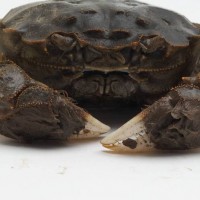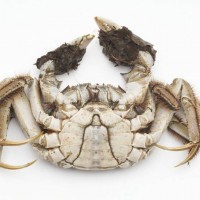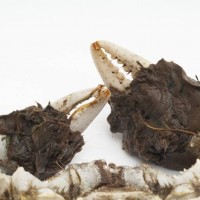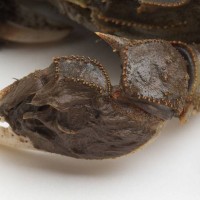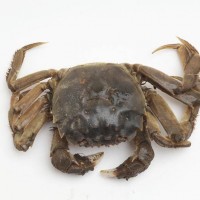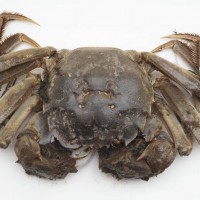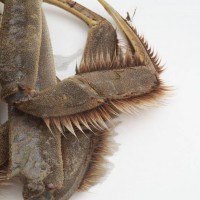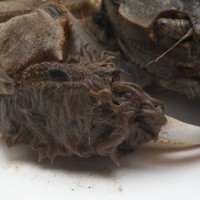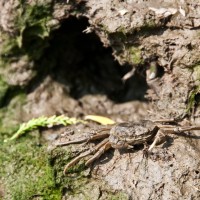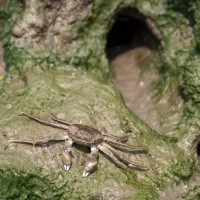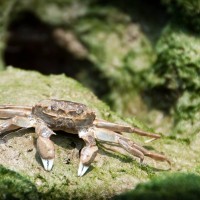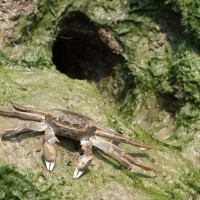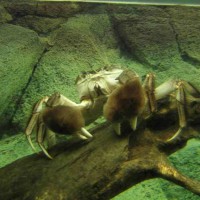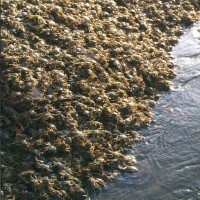Chinese Mitten Crab - Eriocheir sinensis
Expand and collapse the sections below by clicking on the title or + / - icons.
Short description of Eriocheir sinensis, Chinese Mitten Crab
A large crab with a maximum carapace (body) length of 56 mm. The carapace is quite square in outline, narrowing towards the front and has four teeth on each side. Olive green in colour with paler legs, which are twice the length of the body. The most obvious distinguishing feature of the Chinese mitten crab is the dense mat of hair on the claws. The leading edges of the legs are also very hairy.
Impact summary: Eriocheir sinensis, Chinese Mitten Crab
Can impact marine and freshwater ecosystems. A voracious predator that will consume a range of invertebrate species and the eggs of fish leading to competition with native species and impacting invertebrate and fish populations. Will burrow into river banks, increasing erosion and river turbidity, and causing bank collapse. Burrowing will also lead to the siltation of gravel beds, including those used for fish spawning.
Habitat summary: Eriocheir sinensis, Chinese Mitten Crab
Juveniles occur in lower estuaries and marine habitats. As they develop, young crabs migrate upstream, into freshwater and brackish systems. Adults usually live in burrows in muddy riverbanks, although aquatic vegetation and marshes may provide an alternative habitat. Adults migrate into deep, open, saltwater locations to reproduce.
Overview table
| Environment | Marine and Freshwater |
|---|---|
| Species status | Non-Native |
| Native range | Eastern Europe, Eastern Asia |
| Functional type | Omnivore |
| Status in England | Non-Native |
| Status in Scotland | Non-Native |
| Status in Wales | Non-Native |
| Location of first record | Thames Estuary |
| Date of first record | 1935 |
Origin
Originates from eastern Asia, in temperate and tropical regions between Vladivostock (Russia) and southern China, including Japan and Taiwan. The centre of occurrence is the Yellow Sea (temperate northern China).
First Record
Chinese mitten crabs are thought to have been present in the Thames estuary since 1935.
Pathway and Method
The most likely pathway is in ballast water associated with shipping. Although individuals may be transported with mariculture and clinging on to ships’ hulls.
Species Status
Current European range extends from Finland, through Sweden, Russia, Poland, Germany, the Czech Republic (Prague), Netherlands, Belgium and England, to France. There have been many sightings across North America, and the species has become established throughout much of the San Francisco estuary. The first GB record was from the Thames estuary at Lots Road Power Station in 1935. By 1998, the species was found in most Thames tributaries downstream and 65 km to the west in the River Colne at Staines.
Dispersal Mechanisms
In the autumn, Chinese mitten crabs will migrate up to 1500 km down rivers to the sea to reproduce. Pelagic larvae may be transported by water currents or in ballast water, but once settled in estuaries, young will move up to 1000 km upstream to freshwater while growing. Adult mitten crabs can also travel over land for long distances.
Reproduction
Males and females travel downstream during late summer and attain sexual maturity in tidal estuaries. In the UK, mating starts in October and continues to at least February. After mating, males travel back upstream while the females are thought to continue downstream towards the sea to over-winter in deeper waters before moving back into brackish waters to hatch their eggs in the spring. After settlement in the lower estuary the juvenile crabs will migrate upstream to fresh water, whilst growing to adult size. Females carry between 250,000 to 1,000,000 eggs attached to the underside of their abdomen.
Known Predators/Herbivores
Little is known about the potential predators of the Chinese mitten crab although it is likely that juveniles may be consumed by larger crustaceans, fish, birds, cephalopods and mammals.
Resistant Stages
Adults are resistant to a wide range in salinity and temperature. Larvae require higher levels of salinity and are more sensitive to low temperatures. They have a microscopic phase, during which they are very difficult to detect.
Habitat Occupied in GB
Early stages are found in lower estuarine areas with saline conditions. Adults are usually found in fresh or brackish waters in rivers. Muddy banks are required to provide habitat to burrow into for protection. Although aquatic vegetation in shallow, open waters such as marshes can provide an alternative refuge to burrowing. Adult females are often found in saltwater, particularly deep, open waters in bays.
Originates from waters in temperate and tropical regions between Vladivostock (Russian Far East) and South-China, including Japan and Taiwan. Centre of occurrence is the Yellow Sea (temperate regions of North-China).
The Current European range extends from Finland, through Sweden, Russia, Poland, Germany, the Czech Republic (Prague), Netherlands, Belgium and England, to France. There have also been many sightings across North America, and the species has become established throughout much of the San Francisco Estuary.
Common in the River Thames and River Medway, with isolated records from River Tyne (Newcastle), the River Tamar (near Plymouth) and recently Dungeness, Kent. Also recorded from Southfields Reservoir near Castleford, Yorkshire.
Environmental Impact
Likely to impact native, benthic invertebrate populations in freshwater and marine systems, through predation and competition for space. Has the potential to outcompete the native white-clawed crayfish. May cause siltation of gravel runs used for spawning by salmon and trout.
Health and Social Impact
In its native range, the Chinese mitten crab carries a number of diseases, including a Ricketsia-like organism (RLO) associated with tremor disease and black gill syndrome. It is also a second intermediate host of the Oriental lung fluke, which may affect humans. However, it is unlikely that this disease will spread in GB due to the absence of the primary host snail species, which is unlikely to occur due to cold temperatures.
Economic Impact
Economic impacts are unpredictable, however, high costs may be associated with repairing flood defences, land reclamation and river banks damaged by burrowing. Costs may also be associated with loss of salmon and trout fisheries and where other commercially important species are impacted by predation and competition. There is a potentially high commercial value associated with Chinese mitten crabs and should fisheries become established, potential fishery impacts on native species, such as the common eel would need to be investigated.
Identification
Biology, ecology, spread, vectors
Anger, K. (1991) Effects of temperature and salinity on the larval development of the Chinese mitten crab Eriocheir sinensis (Decapoda: Grapsidae). Marine Ecology Progress Series, 72, 103-110.
Clark, P. (2005) Chinese mitten crab Eriocheir sinensis. Marine Aliens - conserving native biodiversity by raising awareness of invasive species [on-line]. Plymouth: Marine Biological Association of the United Kingdom Available from MarLIN
Clark, P.F., Rainbow, P.S., Robbins, R.S., Smith, B., Yeomans, W.E., Thomas, M. & Dobson, G. (1998) The alien Chinese mitten crab, Eriocheir sinensis (Crustacea: Decapoda: Brachyura), in the Thames catchment. Journal of the Marine Biological Association of the United Kingdom, 78, 1215-1221.
Herborg, L.M., Bentley, M.G., Clare, A.S. & Last, K.S. (2006) Mating behaviour and chemical communication in the invasive Chinese mitten crab Eriocheir sinensis. Journal of Experimental Marine Biology and Ecology, 329, 1-10.
Rudnick, D.A., Hieb, K., Grimmer, K.F. & Resh, V.H. (2003) Patterns and processes of biological invasion: The Chinese mitten crab in San Francisco Bay. Basic and Applied Ecology, 4, 249-262.
Management and impact
Rudnick, D.A., Hieb, K., Grimmer, K.F. & Resh, V.H. (2003) Patterns and processes of biological invasion: The Chinese mitten crab in San Francisco Bay. Basic and Applied Ecology, 4, 249-262.
General
Clark, P. (2005) Chinese mitten crab Eriocheir sinensis. Marine Aliens - conserving native biodiversity by raising awareness of invasive species [on-line]. Plymouth: Marine Biological Association of the United Kingdom Available from MarLIN
Spotted this species?
Distribution map
View the Distribution map for Chinese Mitten Crab, Eriocheir sinensis from NBN Atlas
Risk assessment
Risk assessment for Eriocheir sinensis. See a full list of non-native species Risk assessments.
ID Sheet
ID Sheet for Eriocheir sinensis . See a full list of non-native species ID Sheets.
Legislation
Chinese mitten crab, Eriocheir sinensis, is a Species of Special concern. Read more about Non-native species legislation.
Watch a video about this species

